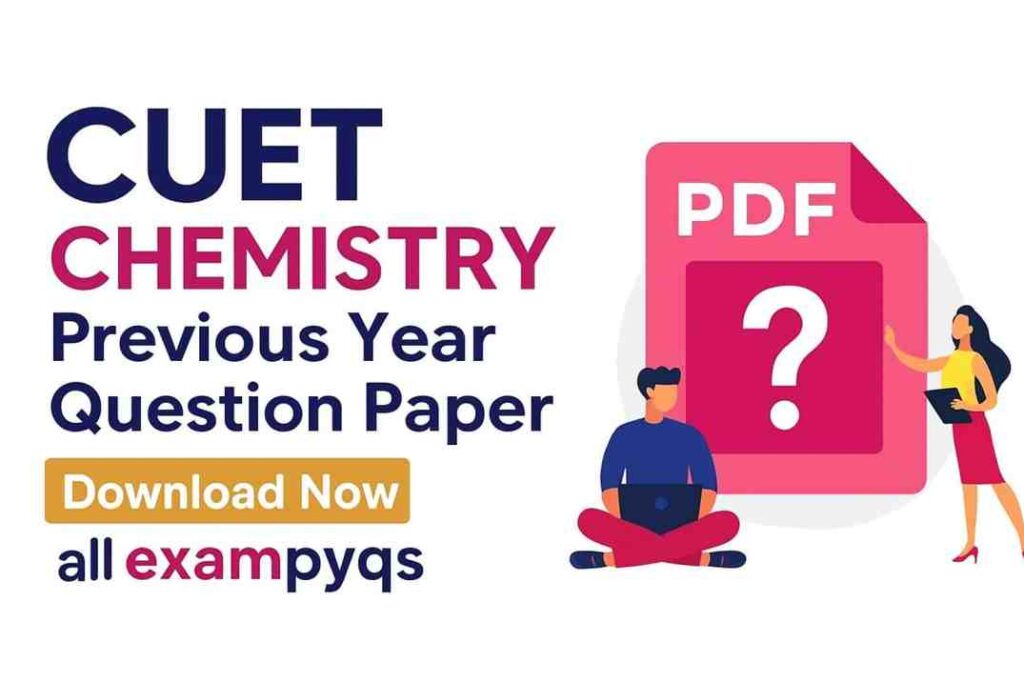📅 Published on: 17.10.2025
Table of Contents
ToggleCUET Chemistry PYQ – PDF Download with Solution

If you’re preparing for the CUET UG Chemistry section, solving CUET Chemistry PYQ (Previous Year Questions) is the smartest way to boost your score. These question papers are more than just practice material — they are a window into the real exam pattern, difficulty level, and question trends.
In this article, you’ll find everything you need: direct CUET Chemistry PYQ PDF download with solution, syllabus overview, best books, important topics, expert preparation tips, and FAQs to guide your preparation from start to finish.
Why CUET Chemistry PYQ Is Important
CUET Chemistry is conceptual, numerical, and memory-based — all at once. Going through the CUET Chemistry Question Paper previous years gives you clarity about:
- Frequently asked chapters
- Commonly repeated numerical concepts
- Difficulty level of the paper
- Real question phrasing and distractors in options
By solving Chemistry Question Paper CUET sets regularly, you develop the exam mindset, learn time management, and strengthen your problem-solving ability — all of which are vital for securing a top percentile.
CUET chemistry question paper 2025
Let’s start with what you came for — the CUET Chemistry PYQ PDF Download with Solution.
You can easily download all official and memory-based question papers with solutions from the sources below:
CUET chemistry question paper 2024
The CUET Chemistry Question Paper 2024 is available in two versions — Code EA and Code EA (New) — each divided into Sets A, B, C, and D. These papers help you practice real CUET-level questions and understand the latest exam pattern. Download each paper in PDF format below and start practising today.
CUET Chemistry Question Paper 2024 | Download PDF |
CUET Chemistry Code EH-Set A | |
CUET Chemistry CodeEH -Set B | |
CUET Chemistry CodeEH-Set C | |
CUET Chemistry CodeEH -Set D | |
CUET Chemistry CodeEH (New) -Set A | |
CUET Chemistry CodeEH (New)- Set B | |
CUET Chemistry CodeEH (New)-Set C | |
CUET Chemistry CodeEH (New) -Set D |
CUET chemistry question paper 2023
The CUET Chemistry Question Paper 2023 gives students a complete idea of the actual exam pattern, question types, and difficulty level set by NTA. Many questions in CUET 2024 and 2025 were seen to follow a similar trend as the 2023 Chemistry paper, making it an essential practice resource. By solving the CUET Chemistry PYQ 2023, students can identify frequently asked concepts from chapters like Chemical Kinetics, Coordination Compounds, Thermodynamics, and Organic Reactions. Downloading and practising these question papers with solutions helps you improve accuracy, manage time effectively, and boost your confidence for the upcoming CUET exam.
CUET PYQS
Best Books for CUET Chemistry Preparation
To make the most of the CUET Chemistry PYQ, pair them with the right books. Here’s a quick guide to what you should use:
1. NCERT Chemistry (Class 11 & 12)
The backbone of CUET Chemistry. Almost 70–80% of the questions come directly from or are inspired by NCERT lines and examples.
2. NCERT Exemplar Problems
Helps you understand tricky and conceptual questions that are often repeated in the Chemistry Question Paper CUET.
3. CUET-Specific Books
•“CUET UG Chemistry Book – Target Publications”
•“Together with CUET Chemistry Solved Question Bank” (Rachna Sagar)
•Arihant CUET Chemistry Practice Book (with PYQs & Mock Tests)
4. Reference Books
•Physical Chemistry by O.P. Tandon
•Organic Chemistry by Morrison & Boyd
Use NCERT for theory, and these CUET-specific guides for question-level practice and mocks.
Important Topics in CUET Chemistry PYQ
Analyzing past CUET Chemistry Question Papers, certain topics appear more frequently. Focus on these high-weightage chapters:
Section | Important Topics |
Physical Chemistry | Thermodynamics, Electrochemistry, Equilibrium, Chemical Kinetics |
Inorganic Chemistry | Periodic Trends, Chemical Bonding, p-Block, Coordination Compounds |
Organic Chemistry | Hydrocarbons, Carbonyl Compounds, Amines, Alcohols & Phenols, Isomerism |
Applied | Polymers, Biomolecules, Chemistry in Everyday Life |
You may like also
CUET Chemistry Preparation Tips
If you want to score high in CUET Chemistry, you need a smart, structured, and time-efficient strategy. Here’s a detailed guide to make your PYQ practice more effective and result-oriented.
1. Understand the Pattern
Before you begin solving questions, you must know the exam structure inside out. The CUET Chemistry section typically consists of 50 questions, out of which you need to attempt 40. Each correct answer carries 5 marks, and there’s a −1 penalty for every wrong attempt. Understanding the paper pattern helps you decide which questions to skip, how much time to spend on each, and how to maximize accuracy while minimizing negative marking.
2. Follow the “NCERT → PYQ → Mock” Formula
This simple yet powerful approach builds a strong foundation and exam readiness. Start by studying the entire syllabus from NCERT Chemistry Class 11 & 12, as most CUET questions are directly derived from it. Next, solve topic-wise CUET Chemistry PYQ to see how concepts are applied in real exams. Finally, take full-length mock tests to evaluate your preparation level, improve your speed, and adapt to real exam pressure.
3. Time Yourself
Practising under timed conditions is the best way to simulate the CUET exam environment. Set a 60-minute timer for each practice paper and try to complete it without any distractions. This habit improves your time management, helps you stay calm under pressure, and ensures you can attempt all 40 questions confidently within the allotted time.
4. Analyze Mistakes
Solving papers alone isn’t enough — the real learning happens when you review them. After every test, carefully go through the solution PDF and identify your mistakes. Note down the topics you got wrong, concepts you forgot, and any calculation errors you made. Revising this “mistake list” weekly ensures you don’t repeat the same errors in future tests and helps you solidify your weak concepts.
5. Focus on Weak Areas
Every student has certain chapters that feel more difficult — whether it’s Organic Chemistry mechanisms or Inorganic periodic trends. Instead of ignoring them, dedicate extra time to revise and practice those topics. Use NCERT examples and PYQs to understand how questions are framed from these areas. Strengthening your weak topics will increase your overall accuracy and balance your preparation.
6. Use Formula Sheets
Physical Chemistry is full of formulas and constants, and remembering all of them during revision can be tough. Prepare a one-page summary sheet containing all essential formulas, conversions, and equations. Keep it handy for quick revision before the exam. Regularly revising this sheet will help you recall formulas instantly during problem-solving, saving you valuable time in the exam.
7. Attempt Topic-Wise PYQs
Instead of jumping randomly between papers, practice topic-wise previous year questions. For example, solve all past questions from “Electrochemistry” or “Alcohols and Phenols” together. This approach helps you recognize frequently asked concepts, question styles, and difficulty levels for each chapter. It also reinforces conceptual clarity and strengthens your preparation for every unit individually.
8. Stay Consistent
Consistency is the real key to success in CUET Chemistry. Make a weekly plan — for instance, solve at least one full Chemistry Question Paper CUET every week and revise important notes daily. Avoid cramming before the exam; instead, focus on steady progress. Regular practice keeps your memory fresh, builds confidence, and ensures you stay exam-ready at all times.
Conclusion of CUET Chemistry PYQ
Solving CUET Chemistry PYQ – PDF Download with Solution is not just about revising old papers — it’s a complete learning strategy. It helps you analyze trends, master the syllabus, and identify your weak areas well before the exam.
Combine these question papers with NCERT books, targeted revision, and mock practice. If you follow this method consistently, you’ll find the CUET Chemistry paper straightforward and score a top percentile with ease.
So, download your CUET Chemistry Question Paper PDF today, set a timer, and begin practising. Remember — every question you solve takes you one step closer to your dream university.
FAQs
Q1. Where can I download CUET Chemistry PYQ PDFs with solutions?
You can download them from official NTA resources or trusted educational sites like AllexamPyqs.com
Q2. Are CUET Chemistry Question Papers from previous years useful?
Yes! They show real exam patterns, common topics, and question difficulty, making them extremely valuable for practice.
Q3. Is NCERT enough for CUET Chemistry?
NCERT is the foundation. However, solving CUET Chemistry PYQ and sample papers is essential to bridge theory and application.
Q4. Which section is most scoring in CUET Chemistry?
Physical Chemistry and Organic Chemistry are often the easiest to score if your basics are clear.
Q5. How many PYQs should I solve before CUET?
Try to complete at least the last 4–5 years of Chemistry Question Paper CUET, plus 5–10 mock tests for strong performance.




